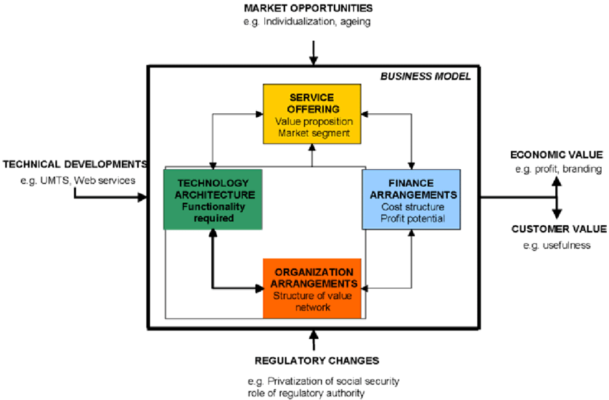STOF Business Model
STOF model: a ‘holistic’ view on business models
There are a lot of different business models. One example of this is the STOF model. By using a business model, value creation can be created in a systematic and structured way. A business model is a consistent description of the structural coherence of factors related to experience and being shaped by the organization. A business model is actually a kind of description of how organizations deploy and offer innovative services in an economically feasible way. Many different business models are available; here, we introducing the STOF model. The model is specifically aimed at (mobile) service innovations. STOF helps you to visualise your business model and how you collaborate with partners. A business model describes how you create, deliver, and capture value.

By using the STOF model, four interrelated perspectives are approached:
- service
- technology
- organisation
- finance
STOF creates a shared understanding of your business model and shows how your company fits within the network of partners.
The Service domain comprises the value proposition and the market segment. Technology contains itself with the necessary technical functionality of the product. Organization contains itself with the structure of the value network. The financial aspects are considered in more detail in the Financing domain. STOF helps to visualise a company’s business model and how to collaborate with partners and describes the business model from four connected perspectives.
According Bouman et all the STOF model provides a ‘holistic’ view on business models with these four interrelated perspectives it elaborates on critical design issues that ultimately shape the business model and drive its viability.
The advantages of using STOF is
- The STOF business model represents a multidisciplinary background and is based on concepts and theories from different disciplines. STOF method is a practical method and has the advantage that it focuses on a specific service concept (services and innovations) and the relevant value network that provides that service. The STOF method is not that strict and there is not a set of predefined values. And therefor it makes it possible to integrate this method in design thinking methods to develop or/ and improve new insights into the strategy of the organization. It lends itself well to link critical design factors, and therefore the factors are characteristics of an organization that describe what an organization needs to be successful and how the objectives will be achieved.
- The STOF model is a dynamic model. The development process from a business idea to an established business can be structured in several stages. Integrating these phases into a business model helps to understand the influence of an innovation on the strategy of the business and the business model itself.
- The stakeholders play a major role within the STOF model and the underlying relationships with various stakeholders can also be clearly mapped out.

Value proposition and customers
Customers and end-users
- Who is the customer?
- Who will pay for the service?
- Who is the end-user?
- Who will be using the service?
Value proposition and service offering
- In what specific situation(s) would people want to buy or use the service (use cases)?
- What does the service do for the customer or end-user?
- What are the unique and distinguishing benefits of the service?
- What is the actual offering provided to the customer or end-user?
- What are the distinguishable elements of the service?

Architecture and systems
Technical Functionality
- What (business) functions does the service require?
- What is the global architecture of the service offering?
Applications (user applications running on the technological system)
- What user applications should be running on the technological system ( e.g. for communication, interaction, content distribution, transactions)?
- How are customer profiles and privacy managed?
- How is secure access to, and use of, services arranged?

Partners and collaboration
Actors
- Which business roles are required to create and deliver the service?
- Which actors can and want to cooperate and take up the business roles?
Actors’ resources & capabilities
- What are capabilities and resources that these actors can or should provide?
- Which resources and capabilities are critical? Hence which actors are preferable?

Cost and revenues
Costs
- What is the cost structure of the service?
- Investment costs, fixed costs and variable costs?
Revenues
- What is the revenue model behind the service or product?
- > direct payments: one-off sale, subscriptions, licenses, pay-by-tweet
- > indirect payments: advertising, sponsoring, subsidies, commissions
Financial arrangements
- How are investments, costs and revenues divided over the actors?
More information and success factors with the STOF-method and dozens of real-life cases in telecom, ICT, media, independent living and energy domain see for an overview, Bouwman et al, 2008
The STOF method has been developed since 2002 by the Telematica Instituut (later Novay) and TU Delft in various research projects, such as Freeband, BiTa and B4U. See: Bouwman, de Vos & Haaker (2008); Faber & de Vos (2008) and Haaker (2012). The description of the STOF method here is largely based on a summary given in Van Vliet et al. (2014)
